
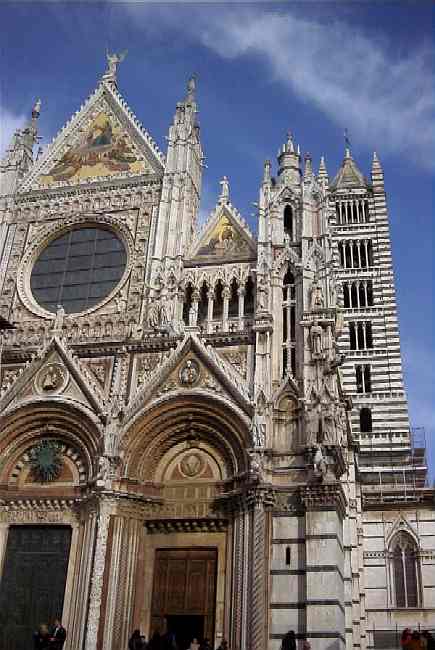
Our trip down to brown and bricked Siena (yes, that's where the name of the "burnt" crayon color comes from -- Gee, you are old!) was uneventful as we passed through the hilly Tuscany countryside. Soon we were on the edge of Siena, trying to find our way to the center city (which we didn't quite do) and find a parking spot (which we assumed to be impossible and so preemptively parked far away and hoofed it in through a residential district and through the city gates ).
As always in an old Italian town, our first stop was the cathedral, the Duomo, since that is usually the chief depository for whatever passed for culture from about 1000 AD, long before millenium bugs were invented. Siena's is a beautiful black and white marble Romanesque/Gothic masterpiece (depending upon where you look). Paradoxically, the Duomo is both finished after about 150 years starting in the 12th century (as we see from the picture at the top), and unfinished (as we see below in the gaping empty arches: )
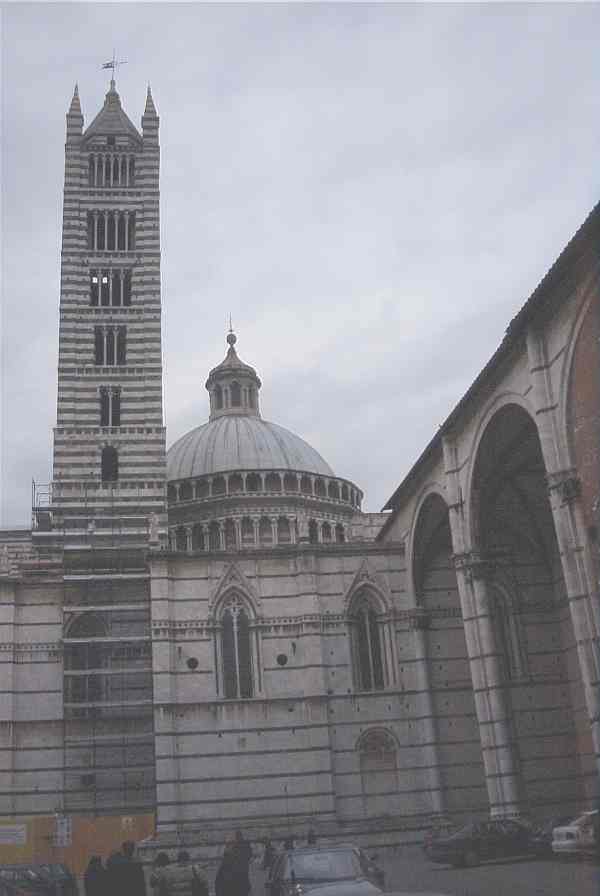
In the mid 14th century, the Sienese -- at the peak of their prosperity -- decided to expand the church to be the largest in the world. Consequently they added the arches above as a long nave with the intent of converting the existing nave into the transept. Obviously they were in a cathedral war with their big rivals of Pisa and Florence. Unfortunately, the Black plague raised its ugly bacteria at that time, wiping out about a third of the population of Europe and hitting Siena even harder (about 75%!). Shortly thereafter, the Florentines killed off all but about 8000 Siena inhabitants. What had been a city which rivaled Florence in almost every way for 400 years became a survivor. What was bad news for Siena became good news for history as the town no longer had the capacity to keep up with the times, missed the Renaissance, and today is pretty much a frozen high gothic museum within its still-standing walls. But let me finish this long-winded paragraph by saying that up until the Siena Duomo, we thought we had seen enough unfinished churches in Florence. But the Siena duomo was clearly in a unfinished league of its own. It gets worse: Parts of the structure were unstable so the Sienians actually had to tear some of it down. This probably happened a lot as engineering standards were not at the high level they are today. (Excuse me, I better save this as I think my computer is about to crash).
Unfinished on the outside, that is. Inside the Cathedral easily outdoes the plain interior of its Florence rival. The church pillars, made of stacks of light and dark green marble, give this space a luxurious horizontal effect. The floor boasts of over 50 etched inlaid marble panels which are alternately covered to protect them while people walk over them to view the uncovered panels. The covers are rotated so if you lived in Siena, you probably could see them all (but would probably never go to the Cathedral). Recorded Gregorian chant lightly bounces around all this marble as sort of a divine Muzak.
Below is a picture of the dome interior:
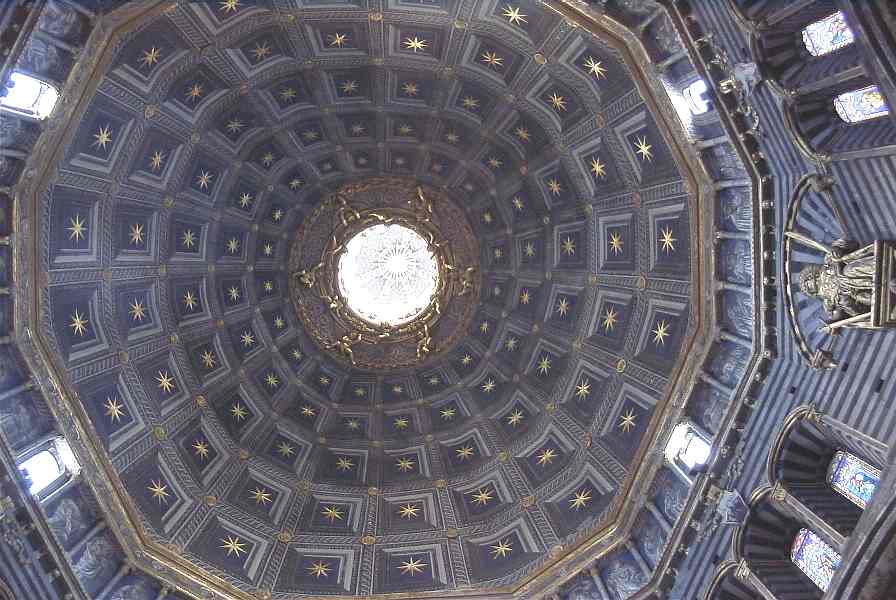
Nice, but Brunelleschi's dome in Florence is clearly better. The outside of this dome has two porches (loggia) similar to the wedding cake tiers of the leaning tower of Pisa (stay tuned -- but until then, look at the "unfinished" picture up above). You probably remember that the Florentines were building such an outside gallery on their more famous dome until Michelangelo's catty remarked stopped them in their tracks.
Besides fighting over domes, the great Tuscan towns of Siena and Pisa competed for the best pulpit (by using the same artists). Here's the Siena version by Nicola Pisano and sons:
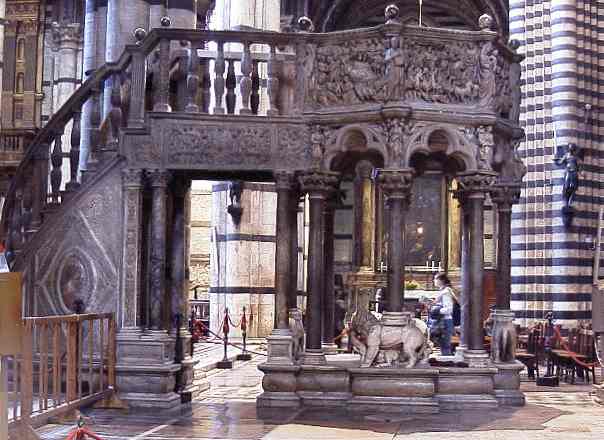
The top is an octagon with one side missing so the lector can get through. The remaining seven sides feature scenes from the life of Christ. Nine columns with lion bases support the whole carving. We will talk more about Pisano when we get to his Pisa pulpits.
But what impressed us most was the Libreria Piccolomini, a library built by a cardinal to house his Uncle's (Pope Pius II) books. (The Piccolomini were one of Siena's most prominent families. In fact, the cardinal who built the library became briefly Pope Pius III.) The library walls and ceiling are frescos by Pinturicchio in the early 16th century. These ten intricate and highly colorful panels chronicle the life of Puis II underneath a ceiling similarly decorated with mythic scenes. Here's two of those ten panels:
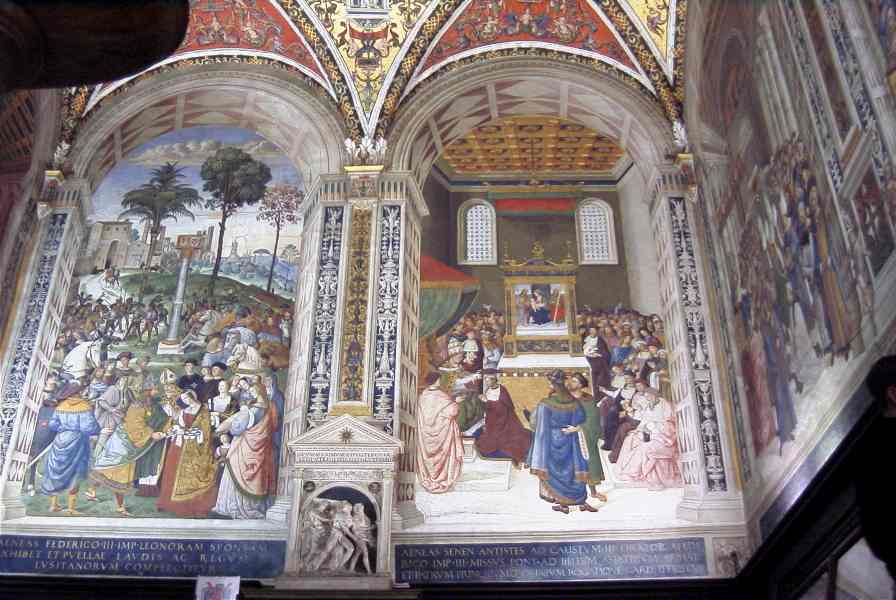
The scene on the left may be of Pius II welcoming back the Christian fleet that he convinced into attacking the Turks. Pius II was quite the Renaissance man even though he came from Gothic Siena as he was a poet, diplomat, etc.
After leaving the cathedral we had another incredible guide book Tuscan lunch. By this time we were not missing Paris at all. Our next stop was one of the most famous "squares" in the world -- the Piazza del Campo. Please join us by clicking here.
Where do you want to go today? Here's a few choices:
